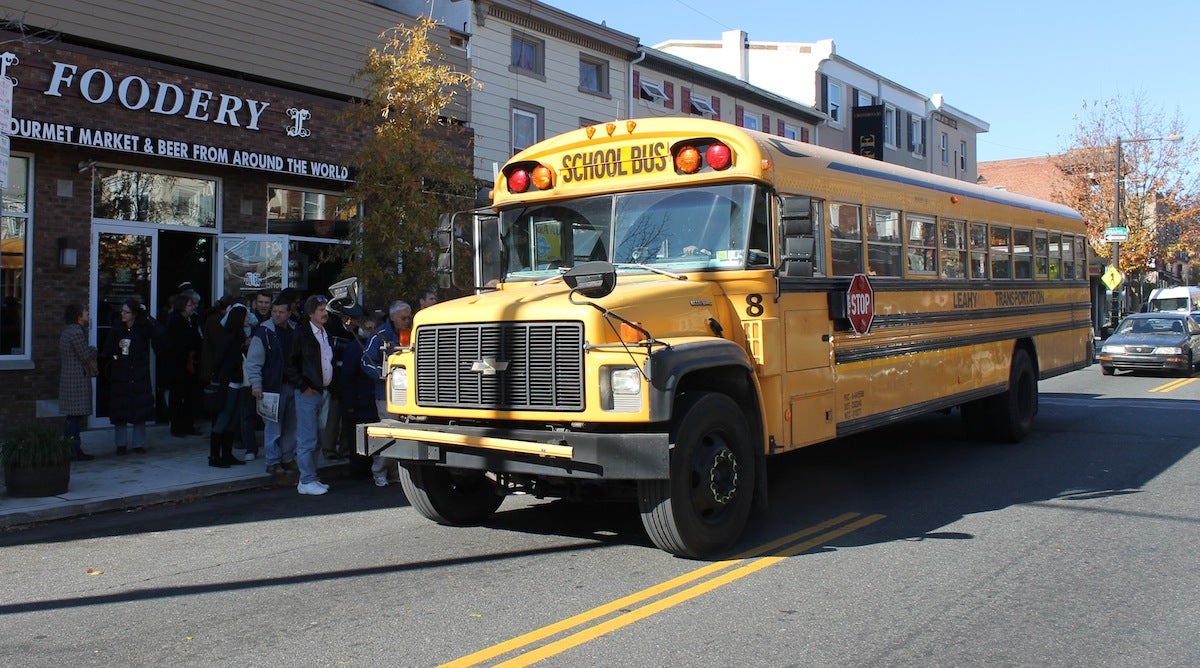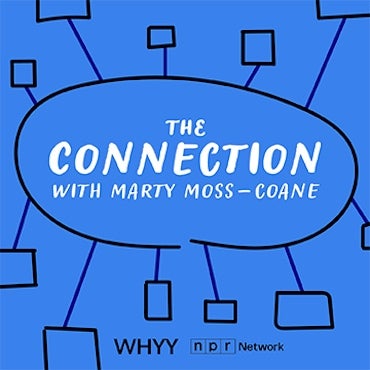More than 50 residents attend zoning hearing to oppose proposed Wendy’s in Roxborough

Roxborough resident John Boyce rented a bus to transport community members to Wednesday's meeting. (Matt Grady/for NewsWorks)
On the bus that ferried concerned citizens to the zoning hearing downtown, a positive energy prevailed. With almost every available seat occupied, space on the rented school bus was tight, but it didn’t dampen a sense of optimism.
At stake was what some considered the future of Roxborough. Developers Frank and Anthony Giovannone are attempting to build a Wendy’s fast-food restaurant with a drive-thru on the site of the former Bunting House at the intersections of Ridge and Roxborough avenues, which was a demolished after a lengthy public effort to save the historic residence.
Roxborough resident John Boyce was so upset at the prospect of such a restaurant that he rented a bus at a personal cost of $305 in order to transport community members to the hearing, held on Wednesday.
Boyce also picked up the tab on the pastries that were passed from one seat to another.
“This is a black and white issue,” said Boyce, expressing his opposition. “That’s why there are 53 people on the bus.”
Community opposition
The day’s proceedings’ hinged upon part of the Philadelphia code 14-303 (7), known as special exception. It’s sort of like a variance, but with different burdens of proof. While the developers could build a Wendy’s by-right, a special exception would be needed for the drive-thru window, and possibly for proposed signage at the site.
Arriving at the Municipal Services Building, residents expressed their optimism.
Kevin Smith, president of the Manayunk Neighborhood Council, said he was “reasonably confident and relaxed” as he approached the elevator banks.
“It should be a good case,” he said. “It’s one where everyone is against it.”
On line to enter the hearing room, Kimberley Bezak stood watching her 22-month old daughter, Ava.
“We’re trying to teach her from an early age to fight for what she believes in,” said Bezak, whose own confidence for community victory was undergirded by opposition for the project by the Roxborough Development Corporation, the Central Roxborough Civic Association, and Fourth District Councilman Curtis Jones, Jr.
Both sides of the battle
Inside the hearing room, the neat rows of blue pleather chairs were quickly filled. Eventually, the crowd would be so sizable that it spilled out into the hallway.
While the masses waited for hearing to begin — at least one Zoning Board of Adjustment official was stuck in traffic, triggering a 37-minute delay — attorneys for both sides had opportunity to summarize their positions to NewsWorks.
Representing the community was Hal Schirmer, who indicated that there was a critical distinction to make between a free-standing Wendy’s and a take-out restaurant in an existing building, such as nearby Dalessandro’s Steaks or the pizza shop that once existed on the proposed Wendy’s site.
“It’s really about size and scale,” said Schirmer.
Representing the developers was Carl Primavera. While affirming that the key issue was the drive-thru window — Wendy’s representatives said that the restaurant wouldn’t be built without one — he hoped that community members kept an open mind about the presentation, which included some design changes made since a boisterous public meeting in October.
Traffic implications
From his position between the four ZBA members and the roomful of observers who were largely against his clients, Primavera performed an impressive juggling act, balancing prepared testimony, expert witnesses, pointed questions from the board, Schirmrer’s cross-examination, and various display boards bearing designs and photographs.
One, an Elmer’s brand trifold display board, required the assistance of a second attorney.
The first witnesses for the developers were site and traffic engineers for the project. Traffic engineer Frank Montgomery came under scrutiny, with pointed questions asked by the ZBA about traffic predictions for the site.
While Montgomery said that 83 vehicles would visit the site during peak dinner hours — approximately 65 percent of which would be drive-thru customers — it was Primavera who suggested that traffic is associated with commerce.
“The only business that doesn’t have a traffic impact is one that is closed or failing,” he said.
Urban vs. suburban
Despite an increasing restlessness in the crowd, the factual and emotional aspects of the developer’s presentation hinged on the testimony of land planner Dennis Glackin. In order to obtain a special exception, several elements must be satisfactorily addressed by the applicant under 14-303 (7e.2), including street congestion, overcrowding on land, effects on adjacent properties, impact on schools and stormwater, etc.
Running down the list, Glackin was snared on the point that required the special exception meet the city’s comprehensive plan. He proposed that the restaurant would do so by creating jobs, expanding tax revenue, and eliminating vacant property.
Zoning board chair Julia Chapman challenged him on the final point, and when Glackin replied that the land had been vacant for two years, she retorted, “Try two months.”
Upon further questioning, Glackin asserted that he believed that Wendy’s would be contextually appropriate for a commercial corridor. Chapman reminded him that it was an urban, not suburban, neighborhood commercial corridor and suggested that a sit-down family restaurant would be most desirable usage.
“And I’d like to look like Brad Pitt,” countered Primavera. “It’s not the most desirable, it’s not who has the most money, it’s what the law is.”
Signage and sales volume
After a cross-examination by Schirmer that focused on the typical uses for the type of zoning designation the plot falls under — overwhelmingly small mom and pop restaurants, according to Schirmer — Glackin concluded his testimony at approximately ten minutes short of 3 p.m.
Chapman announced to a much less crowded room that the community’s presentations would be rescheduled for another time, acknowledging that it was the ZBA’s “bad” for starting a half-hour late.
Using the opportunity to gauge the temperature in the hearing room, Chapman asked for a show of hands, a conservative interpretation of which indicated that there was at the very least a two to one majority opposing the Wendy’s.
Chad Adams, a project manager for Wendy’s, spoke about signage, noting that the site’s main sign would be internally illuminated with manually changeable letters. The smiling, illustrated image of young red-headed Wendy would be eliminated for the Roxborough store.
On his cross-examination, Schirmer asked Adams about a variety of statistics related to the proposed store’s sales volume, but Adams was unable to provide specifics.
Asked to explain the appeal of Wendy’s, he suggested that the consumer doesn’t make a conscious decision; rather, “It’s when the mood strikes you.”
“You don’t consider yourself a destination?” asked Chapman.
“No,” Adams answered. “We may become one, but most of our customers are impulse buyers.”
Going forward
After the bus returned to Roxborough and most participants scattered, Boyce retired to the seating area of the Foodery, where the bus picked up and dropped off passengers, to hold court. Lit from above by a collection of beer signs, Boyce proposed that the form of development exemplified by Foodery — independent, unique, and locally-owned — was the model for future growth in the community, not Wendy’s.
Boyce referred to the developer’s presentation as “self-serving,” saying that the developers monopolized the conversation, “as they’re trying to do with our neighborhood.”
Within minutes, the adjacent table was filled with local civic group leaders who were conducting an informal debriefing. Schirmer remarked that while it was not unusual for a zoning hearing to be continued to a second day, he observed that he’s rarely seen a neighborhood turn out in such force.
“Quantity has a quality all its own,” said Schirmer.
Participation, however, was not the only qualitative marker of the day: Boyce said that he received over $200 in unsolicited contributions toward the rental fee of the bus, which he interpreted as a testament to his neighbors and their common goal of preventing the restaurant.
Come January, he said, “We’ll get the big yellow Wendy’s cheese box again.”
The hearings will resume on Jan. 8, 2014 at 12 p.m.
WHYY is your source for fact-based, in-depth journalism and information. As a nonprofit organization, we rely on financial support from readers like you. Please give today.




